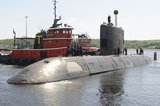InTop LLRAM demonstration completed
Northrop Grumman completed a critical test in the development of the Integrated Topside (InTop) Low-Level Resource Allocation Manager (LLRAM) programme in partnership with the US Naval Research Laboratory (NRL).
The LLRAM was demonstrated in conjunction with the the InTop Electronic Warfare/Information Operations/Communications (EW/IO/COMMS) system at the NRL’s test facility in Chesapeake Beach, Maryland.
The system demonstrated the simultaneous sharing of a single antenna, while flexing its adaptable size and antenna pattern capabilities, and performing a mission that would have previously required multiple dedicated antennas. The test was carried out as part of work to enable future antenna reductions on ships that are already capacity-constrained, allowing for more advanced capabilities in an ever-increasingly complex battlespace environment.
The demonstration showed that the EW/IO/COMMS Advanced Development Model for SEWIP Block 3 can serve as a platform for proving out advanced multi-function concepts using existing NRL test assets.
Mike Meaney, vice president, maritime electronic and information warfare, Northrop Grumman, said: ‘The Northrop Grumman/NRL demonstration of LLRAM concepts was conducted in the same environment that proved crucial to the development of the SEWIP Block 3 EDM.
‘The efficiency of signal sharing capabilities, scalability and advanced resource management capabilities developed on the LLRAM programme will allow for a significantly reduced footprint topside.’
The system leverages four AESA arrays (low band transmit/receive and high band transmit/receive) and intended platforms include cruisers, destroyers and aircraft carriers.
More from Naval Warfare
-
![Will the US Navy surge production for OTH-WS missile?]()
Will the US Navy surge production for OTH-WS missile?
The USN is conducting a market search seeking additional sources capable of supplying 516 units of Over the Horizon – Weapons System Encanistered Missiles.
-
![How will SAFE shape naval procurement for Canada and its highest-receiving members?]()
How will SAFE shape naval procurement for Canada and its highest-receiving members?
Canada’s inclusion on the EU’s Security Action for Europe initiative is set to enhance the country’s defence procurement strategy with important implications for some of its naval programmes, while Poland and Romania have also secured significant SAFE funding.
-
![Maritime defence in the Mediterranean faces challenges from vulnerable land power]()
Maritime defence in the Mediterranean faces challenges from vulnerable land power
As an indispensable energy crossroads, the Mediterranean is at serious risk from grey zone disruption. As navies increasingly employ AI data centres, what happens when cutting-edge defence technologies rely on the very infrastructure most susceptible to hybrid tactics?
-
![US Navy to conduct an experimentation campaign with emerging tech in 2026 and 2027]()
US Navy to conduct an experimentation campaign with emerging tech in 2026 and 2027
The Technology Operational Experimentation Events will inform future requirements as the US Navy looks for innovative solutions across three key operational domains.























